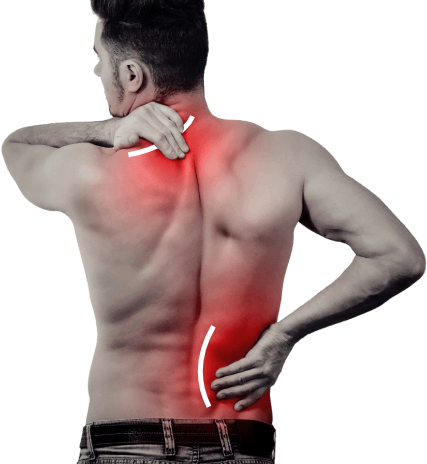Myofascial Pain Syndrome
Myofascial Pain Syndrome
Individuals with MPS develop either localized or generalized muscular pain with stiffness or tightness. These areas of intense tenderness are due to shortening and contraction of injured muscle fibres and will often experience referred pain.
In the first instance, one might feel “knots” or spasms in the area of muscle injury. Referred pain, however, occurs in areas of the body remote from the origin of the problem. For example, you might feel pain shooting down the leg to the calf from a “trigger point” in the buttocks or low back. Alternatively, a headache may be the result of a trigger point in the neck or upper back. A trigger point is the localized area of muscle irritability that disrupts normal muscle function and is the source of both local and referred pain phenomena. It may feel to you like a “knot” or “band” in the muscle and is often very sensitive to even light pressure.

Causes of Myofascial Pain
There are many causes of myofascial syndrome. They include:
1. Trauma from motor vehicle accidents or falls
2. Improper lifting techniques: leading to muscle injury
3. Prolonged stress on muscles: related to poor posture or an inadequate work environment
4. Repetitive use: muscles may be too deconditioned for the particular activity or task
5. Immobilization: after an arm or leg is placed in a cast; or previously active lifestyle suddenly having to stop exercises
6. Pinched nerves: in the spine or in association with surgical correction of these disorders.
Treatment Options
Through a multidisciplinary assessment, once diagnosis of Myofascial Pain Syndrome is made, a multi-dimensional treatment plan is meticulously developed.
1. Localized injection
Patients with discrete tender points in their back or neck muscles may benefit from anti-inflammatory injection to break the pain cycle. This procedure is followed by sustained stretching to help reduce spasm and relax muscles.
The chemicals or medications used in the injections range from Botulinum toxin (used in plastic surgery to get rid of wrinkles) to steroids. These medications can neutralize the knots in the muscle belly and cause restoration of blood circulation to the ischemic area, washing away of toxin and improved oxygenation to the shortened spastic muscle.
2. Low level laser treatment into various trigger points
3. Intensive physical therapy
4. Exercise regime
Frequently Asked Questions
Does Stress Affect the Problem?
Stress and tension is well known to make the discomfort of myofascial pain even worse. Rarely are stress and/or psychological problems alone the sole cause of the problem. Rather, they contribute to a more prolonged course of the condition.
What is the Role of Surgery for Myofascial Pain?
Surgery has little effect in improving MPS. When MPS is misdiagnosed as other spine-related problems, patients may end up with failed surgery outcomes, aggravating their original pain.
Occasionally, patients may improve after general anaesthesia (given as part of treatment during surgery). The overall relaxation of muscles and ligaments during general anaesthesia can break the pain cycle and relieve the pain.
What is the Therapist’s Role During Treatment?
The essential component of healing MPS is an intensive physical therapy intervention designed to break up the trigger point and relieve areas of muscle soreness. Since the muscle shortens in response to injury, effective treatment can only be accomplished if the injured muscles are restored to their normal resting length.
The therapist achieves this by using moist heat, ultrasound, electrical stimulation or other physical modalities to prepare the muscles for stretching by the therapist or, more importantly, the patient himself/herself. Sometimes, a coolant spray will be applied to muscles before they are stretched. We call this technique Spray & Stretch. In many cases, specialized massage performed by the physical therapist or, in some instances, a myotherapist, will help the recovery process.
What is the Patient’s Role During Treatment?
As you gain a thorough understanding of what myofascial pain is, you will appreciate your role in managing your symptoms. It is your commitment that ultimately ensures a good result. We cannot emphasize enough the importance of maintaining a consistent home exercise program. As you begin to feel better, it becomes natural for you to become less committed to your exercises. However, we have found that the most common cause of recurrence or worsening of symptoms is the lack of a comprehensive and consistent exercise program. Make certain to continue your customized exercises on a regular basis. Your participation is important and necessary for your recovery.





